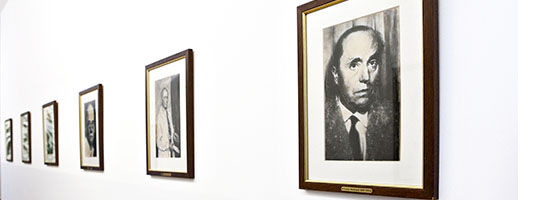
History of the Institute
The Institute as Part of the Hospital Rechts der Isar
| 1875 | The Hospital „Rechts der Isar“ (translating to „Right of the Isar“) established its first yet incomplete Department of Pathology focusing solely on autopsy services. Autopsies were initially done by a department assistant before Hermann Dürck, Assistant Professor at the Institute of Pathology at the Ludwig-Maximilians University (LMU), took over the autopsy service between 1895 and 1899 as a part-time employment. In these times, surgical specimens from the “Rechts der Isar” were evaluated at the Pathology Department of the LMU. |
| 1900 | Eugen Albrecht was appointed as the first full-time Director of the Department of Pathology at the hospital „Rechts der Isar”. Under his leadership a small yet very modern Institute of Pathology was built. The Institute included a state-of-the-art dissection room, a small chapel, a histopathology lab as well as a chemical and a bacteriology lab. The Institute was connected to the hospital complex through an underground tunnel. |
| 1904 | Hans Schmaus became director of the Institute after Eugen Albrecht decided to take a position in Frankfurt. |
| 1905 | After the death of Hans Schmaus, the management of the Institute was taken over by Siegfried Oberndorfer. Oberndorfer later became famous as one of the founding fathers of Turkish pathology. |
| 1911 | Oberndorfer was appointed as head of the Pathology Department at the Munich-Schwabing Hospital and left the “Rechts der Isar”. As his replacement, Hermann Dürck yet again became the director of the Institute. |
| 1935 | Eberhard von Praun, a student of Oberndorfer, became the head of the Department after the retirement of Hermann Dürck. In 1939 the number of surgical specimens evaluated by histology was 975. Von Praun was drafted into military service at the beginning of the Second World War. Therefore, Hermann Dürck agreed on taking over the management of the Department once more. After Dürck's death in 1941, autopsies and histological evaluations were carried out once again at the Institute of Pathology of the LMU until von Praun returned in October 1945. |
| 1955 | Ludwig Burkhard became the successor of von Praun. The focus of the Institute at that time was on clinical pathology, developmental disorders as well as bone and joint pathology. |
The Institute as Part of the Technical University of Munich | |
| 1967 | Under the surgeon Georg Maurer as Medical Director, the hospital “Rechts der Isar” became the University Hospital of the Technical University of Munich. Likewise, the Institute of Pathology was incorporated as a University Department into the Technical University of Munich, as well. |
| 1968 | Burkhard retired and Wolfgang Gössner was appointed as his successor and the first Full Professor of Pathology and Chairman of the Institute of Pathology of the Technical University of Munich. A focus of his work was the advancement of enzyme histochemistry. |
| 1989 | From 1989 to 2015 and following Wolfgang Gössner, Heinz Höfler held the position as Full Professor of Pathology and Chairman. Under his leadership, one of the most modern pathology buildings of its time was built in 1999 at the “Rechts der Isar” campus. In Höfler's time, the focus of the Institute laid on tumor pathology and the introduction of molecular pathology into routine diagnostic. In addition, he established one of the first German tissue biobanks for research. |
| 2005 | The Institute of Pathology of the TUM is accredited for the first time by the German accreditation body (DAkkS), thus certifying high quality in diagnostics and a standardized quality management system in all processes involved. |
| 2015 | After Höfler retired in 2015, Wilko Weichert became Director of the Institute. Under his leadership, the Institute focused on translational morphomolecular pathology in the age of personalized medicine. In addition to the further development of the Biobank of the Technical University of Munich, a Comparative Experimental Pathology Platform and a modern Molecular Diagnostics Unit was added to the Institute. |
| 2021 | The institute introduced digital and computational workflows for clinical pathology. This modernization enabled remote work and home office for pathologists. |
Source: L. Thorn. The history of pathology in Munich. Bayerisches Ärzteblatt No. 2,3,4,5. Reprint 1981; adjusted by Karl-Friedrich Becker and Wilko Weichert.